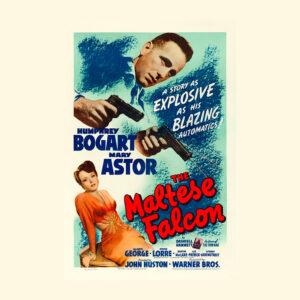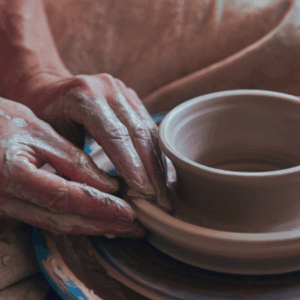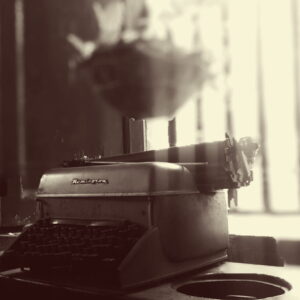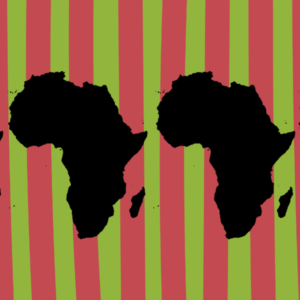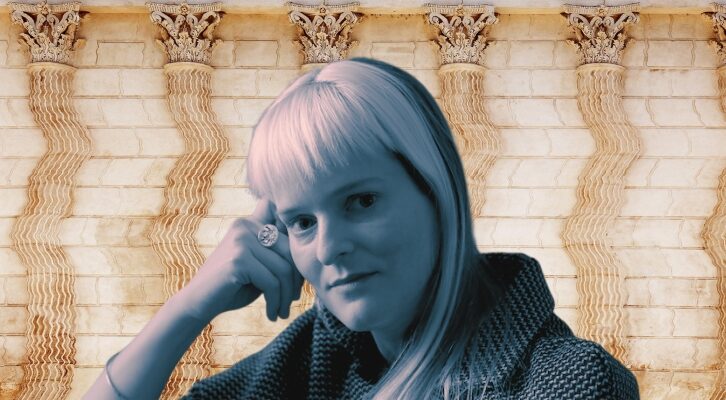
Diana Arterian on Agrippina the Younger, Writing Historical Women, and Poetry as Liberty
The Author of “Agrippina the Younger” in Conversation with Poets.org
Lit Hub is excited to feature another entry in a new series from Poets.org: “enjambments,” a monthly interview series with new and established poets. This month, they spoke to Diana Arterian. Diana Arterian is the author of the poetry collection Agrippina the Younger (Northwestern University Press, 2025) and Playing Monster :: Seiche (1913 Press, 2017), a book-length poem.
With Marina Omar, Arterian co-translated Smoke Drifts, a volume of Nadia Anjuman’s poetry, forthcoming from World Poetry Books. A poetry editor at Noemi Press, Arterian writes “The Annotated Nightstand” column at Lit Hub.
*
Poets.org: What themes do you explore in Agrippina the Younger?
Diana Arterian: On its face, this is a book about a real noblewoman who lived in ancient Rome. The obvious answer to the theme of this collection, then, is history. But, just as it went in the writing, “history” lights up an enormous network of topics—the archive, for one. Because where else would I find information about Agrippina the Younger, a woman who died in 59 CE?
But I quickly found the archive lacking. That little is written or recorded about Agrippina does not make her special. Neither does the fact that none of her words survived, despite her writing three memoirs. In general, any scrap of information about or writing from ancient women the world over is incredibly precious.
These are so rare because women were scarcely thought to be worthy of attention. Simply put: no one copied their words. As the scholar Akira Mizuta Lippit writes, “It is an archive that, in the very archival task of preserving, seeks to repress, efface….” This is true despite the fact that Agrippina was a woman so obsessed with power that she murdered and manipulated her way into the imperial seat (according to history).
So we come to the next theme: power. Of course, there is the drama of power struggles. Who will gain power over the Roman Empire? Who will hold it? Once attained, how do they wield it? But just as important is the far vaster power structures that impact us today. Agrippina indeed attained power, using her emperor uncle-husband and then emperor son as prosthetics.
Considering her herculean effort and miraculous success, the speediness of her undoing is stunning.
Considering her herculean effort and miraculous success, the speediness of her undoing is stunning. She thought she could game the system. She could not. She was a woman in a place where women were legally allowed very little. Here we approach the next crook of the thematic network with misogyny.
The senate’s habitual obsession with women as a threat (to conquest, power, imperial security, male dignity) cannot be overstated. Prior to Agrippina’s birth, Cato successfully argued for an austerity measure that dictated what women wore, where they could ride in carriages, and limited the amount of gold they could own—despite the fact they had no voice in politics and little agency.
The men avoided these restrictions. (Cato’s caustic and misogynist oration reads as chillingly modern and un-unique.)
Finally, considering the length of my answer, perhaps the final looming theme of this book is obvious. While writing these poems for over a decade, I was caught in what James Baldwin calls “the Niagara force of an obsession.” My obsession to understand this woman, so strange considering her ambitions and remarkable intelligence, is on every page.
But equally recurrent is the West’s broader obsession with her family—Agrippina along with emperors Caligula, Nero, Augustus, and others. Explicitly and obliquely, we return to them again and again in paintings, literature, music, television, film. My aim was to understand why. I think, now, I do.
Poets.org: Who or what are your main influences and inspirations in poetry?
DA: I try to move through the world and remain open to anything that may, for one reason or another, sink its fangs in. I read broadly outside the genre and collect facts like a magpie does its shiny objects.
In terms of poetry as a craft, beyond the newer books I grab from my toppling to-read pile, I study the poets no longer living whose work I revere: Ai, Elizabeth Bishop, Gwendolyn Brooks, Theresa Hak Kyung Cha, Forugh Farrokhzad, Louise Glück, Muriel Rukeyser, Sappho.
As I was drafting this, I learned the icon and genius Alice Notley died. Like many, I’m devastated by the loss of such a powerful mind and spirit. The Descent of Alette changed me and my writing, and this book would not exist without it—or her (back in 2014, looking at a few poems on Agrippina, Alice told me to write a whole book about her).
My influences are, also, my writer friends. I’m blessed to have a handful who feel like family. We send each other poems or lines we come across that knock us out. We talk about poetry as art for hours. We read each other’s work and give rigorous critiques. There are few things I cherish more in life than these wonderful, brilliant people. How else will I see the back of my neck unless someone is kind enough to hold up a mirror?
Poets.org: What is your approach to the craft of poetry, and how did it evolve while working on this book?
DA: I heard in an interview somewhere that artists are one of two things: a cat, lounging and waiting for the butterfly of inspiration to flit past, or an ox—in the fields, day in, day out. I’m an ox, if only because of a deeper anxiety that, if I lounge too long, the muses might forsake me. Certainly, some of the fruits of such labor are discarded (okay, most), but it is my way.
If we get nitty-gritty, I’m pencil-to-paper (also for prose—I’m drafting this on paper, now). This slows me down and allows my mind time to edit before I scratch out a word or finish a line. There is endless flexibility while editing on paper—strike-throughs, a few options for a phrase—yet the remnants remain in case you had it right the first time. I realize these are nuts and bolts, but they are part of the larger necessary structure for me.
As an ethos, I try to keep in mind that, as poets, we are the stewards of a holy art. While I don’t mean we should be precious with whom we call “poets,” it is an incredible pursuit.
I try to make a ritual of annually revisiting a Jorie Graham interview with the amazing David Naimon. In it, Graham talks about the act of “cutting into the silence” when poets write. She defines this silence as “the skin of eternity” that “must be respected.”
Graham states that, when one composes lines, we should attempt to “break the silence with something which is equal to the silence and has enough to break out of your personal life into this gigantic element—oceanic, ancient, archaic, that will outlive us all, that precedes us all—which is the silence.”
I often think about this idea, which fights even syntactical sense but is something I nevertheless wholly comprehend. Is my poetry equal to something so sacred and timeless? Is it even worthy of the trees it’s printed on? Of course not. (How could it be?) So I consider how to make that breaking into the silence, the sacrifice, even a little less painful—this is our charge.
So much changed since I wrote the first poem that ultimately began this book. I realized I wanted my writing to be stranger, leaning into the fissures of language. Find where things wobble if you give them a bit of pressure, and push. Stranger, and mine.
Poetry is the most ancient form of creative expression on the planet—we are a simulacrum of innumerable writers before us. Yet I wanted to think of my voice and what I could express that felt unique to me. In that vein, and in terms of the poems’ content, I attempted to develop an assured faith in my impulses.
With little in the archive to refer to, I tried to answer impossible questions about Agrippina myself: What was she like as a child? How did she feel when she got married at thirteen?
Poets.org: What was your “gateway” into the craft of poetry—the poem or poetry collection that made you fall in love with this literary form?
DA: My favorite answers to this question are populated with an insightful librarian or a dogged schoolteacher. Unfortunately, there was little poetry in my schooling—I don’t think my teachers knew what to do with it (Romeo and Juliet was hard enough).
What I do remember is an instance in a British literature survey in college. We were reading part of William Blake’s The Marriage of Heaven and Hell, in which he pointedly asks: “How do you know but ev’ry bird that cuts the airy way / Is an immense world of delight, clos’d by your senses five?”
We discussed this couplet as a class and agreed it meant human beings, despite all we think of ourselves, know very little. How Blake captured that paradigm-shifting insight in a singular image of something fleeting and undeniable as a bird charged through me. But also, the rhythm! The diction! Those few words changed my life.
But my real love story with poetry is like any great love. It perpetually renews itself with the line that steals my breath, the book that renders me speechless for hours. Poetry’s habit to surprise us reminds afresh of the fact that it is so old, so vast, it can allow its practitioners the liberty to do anything they like.
Poets.org: If you could pair one of the poems in Agrippina the Younger with a work of art, song, recipe, or some other form of media, which poem would you choose, and with what would you pair it?
DA: I think of this collection as a book-length poem so I may cheat—and doubly so, for I want to give an array of options that can build a mood for Agrippina. If you want something of the historical period, try the epic films Cleopatra or Quo Vadis or Spartacus. If you want it infused with fantasy, Game of Thrones.
Realistic and contemporary, Succession. A novel, John Williams’ Augustus or Zora Neale Hurston’s The Life of Herod the Great. A very readable history, Mary Beard’s SPQR. The recipe, a simple ricotta cake (libum), which is an ancient Roman dessert. Some music, George Handel’s opera Agrippina. A painting, Gustav Wertheimer’s Der Schiffbruch der Agrippina [The Shipwreck of Agrippina].
But to cheat again (or answer directly?), I did pick a single poem—the first in the book, also called “Agrippina the Younger”—and developed a visual idea with my cinematographer partner for a book trailer.
Poets.org: What are you currently reading?
DA: Like many, my to-read pile is enormous. I’m constantly reinforcing the screws on that shelf to keep it from bucking away from my drywall. Right now, considering the terrifying period we are trying to endure, I am turning toward ancient poetry. Maybe I will absorb the ways they survived (I implore them: teach me!).
Poetry’s habit to surprise us reminds afresh of the fact that it is so old, so vast, it can allow its practitioners the liberty to do anything they like.
The books at hand, which I’m reading or that I itch to start: Grigor Narekatsi’s Lamentations of Narek: Mystic Soliloquies with God (tr. Mischa Kudian); The Mirror of My Heart: A Thousand Years of Persian Poetry by Women (tr. Dick Davis); Enheduana: The Complete Poems of the World’s First Author (tr. Sophus Helle); Li Shangyin (tr. Chloe Garcia Roberts); Elizabeth Bishop’s Geography III; Douglas J. Penick’s The Oceans of Cruelty: Twenty-Five Tales of a Corpse Spirit: A Retelling; Daisy Dunn’s The Missing Thread: A Women’s History of the Ancient World; Don Mee Choi’s Mirror Nation; Dawn Lundy Martin’s Instructions for the Lovers; Omar El Akkad’s One Day, Everyone Will Have Always Been Against This; and Mary Beard’s Women & Power: A Manifesto.
Poets.org: What are your favorite poems on Poets.org?
DA: What an impossible question! If only because this website serves as a capacious, ever-expanding universe of works. Poets.org is a wellspring I return to again and again.
Here are some: Gwendolyn Brooks’ “The Bean Eaters,” C. P. Cavafy’s “The Next Table” (tr. Avi Sharon), Louise Glück’s “Persephone the Wanderer,” Claire Hong’s “zero in on,” Alison C. Rollins’ “[American Journal],” and Sarah Vap’s “who knows how long this way.” If I don’t stop now, I never will!
______________________________
“enjambments,” a monthly interview series produced by the Academy of American Poets, will highlight an emerging or established poet who has recently published a poetry collection. Each interview, along with poems from the poet’s new book, and a reading by the poet, will be published on Poets.org and shared in the Academy’s weekly newsletter.









